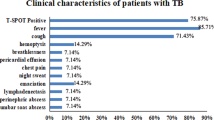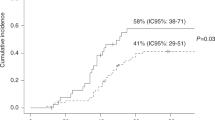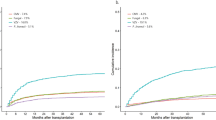Abstract
We evaluated the potential correlation of the hematopoietic cell transplantation comorbidity index (HCT-CI) with the risk of developing post-transplant invasive fungal infections (IFIs). Between January 2009 and March 2015, 312 consecutive patients who received a first allograft entered the study. Low/intermediate HCT-CI risk score (0–2) was observed in 172/312 (55%), whereas high HCT-CI score (≥3) was seen in 140/312 (45%). Overall, 51/312 (16%) patients experienced IFI, defined as possible in 19 (6%), probable in 27 (9%), and proven in 5 (2%). Cumulative incidence of probable-proven IFI at 1 year was 8.5% with a significant higher incidence in patients with high HCT-CI (12%) vs. those with low-intermediate HCT-CI (5%; p = 0.006). There was a strong trend for a higher incidence of baseline severe pulmonary comorbidity in patients who developed probable-proven IFI (p = 0.051). One-year cumulative incidence of non-relapse mortality was higher in patients with IFI vs. those without, 49 and 16% (p < 0.001). By multivariate analysis, disease status at transplant and high HCT-CI, when combined with acute GVHD, were independently associated with the risk of post-transplant IFI. This study shows that a high HCT-CI predicts the risk of developing IFI and may indicate the need of mold-active antifungal prophylaxis in high-risk patients.
This is a preview of subscription content, access via your institution
Access options
Subscribe to this journal
Receive 12 print issues and online access
$259.00 per year
only $21.58 per issue
Buy this article
- Purchase on Springer Link
- Instant access to full article PDF
Prices may be subject to local taxes which are calculated during checkout

Similar content being viewed by others
References
Garcia-Vidal C, Upton A, Kirby KA, Mar KA. Epidemiology of invasive mold infections in allogeneic stem cell transplant recipients: biological risk factors for infection according to time after transplantation. Clin Infect Dis. 2008;47:1041–50.
Girmenia C, Raiola AM, Piciocchi A, Algarotti A, Stanzani M, Cudillo L, et al. Incidence and outcome of invasive fungal diseases after allogeneic stem cell transplantation: a prospective study of the Gruppo Italiano Trapianto Midollo Osseo (GITMO). Biol Blood Marrow Transplant. 2014;20:872–80.
Atalla A, Garnica M, Maiolino A, Nucci M. Risk factors for invasive mold diseases in allogeneic hematopoietic cell transplant recipients. Transpl Infect Dis. 2015;17:7–13.
Sun Y, Meng F, Han M, Zhang X, Yu L, Huang H, et al. Epidemiology, management, and outcome of invasive fungal disease in patients undergoing hematopoietic stem cell transplantation in China: a multicenter prospective observational study. Biol Blood Marrow Transplant. 2015;21:1117–26.
Hemmati PG, Terwey TH, le Coutre P, Vuong LG, Massenkeil G, Dorken B, Arnold R. A modified EBMT risk score predicts the outcome of patients with acute myeloid leukemia receiving allogeneic stem cell transplants. Eur J Haematol. 2011;86:305–16.
Gratwohl A, Stern M, Brand R, Apperley J, Baldomero H, de Witte T, et al. Risk score for outcome after allogeneic hematopoietic stem cell transplantation. Cancer. 2009;115:4715–26.
Armand P, Kim HT, Logan BR, Wang Z, Alyea EP, Kalaycio ME, et al. Validation and refinement of the disease risk index for allogeneic stem cell transplantation. Blood. 2014;123:3664–71.
Sorror ML, Maris MB, Storb R, Baron F, Sandmaier BM, Maloney DG, Storer B. Hematopoietic cell transplantation (HCT)-specific comorbidity index: a new tool for risk assessment before allogeneic HCT. Blood. 2005;106:2912–9.
Vaughn JE, Storer BE, Armand P, Raimondi R, Gibson C, Rambaldi A, et al. Design and validation of an augmented hematopoietic cell transplantation-comorbidity index comprising pretransplant ferritin, albumin, and platelet count for prediction of outcomes after allogeneic transplantation. Biol Blood Marrow Transplant. 2015;21:1418–24.
Raimondi R, Tosetto A, Oneto R, Cavazzina R, Rodeghiero F, Bacigalupo A, et al. Validation of the hematopoietic cell transplantation-specific comorbidity index: a prospective, multicenter GITMO study. Blood. 2012;120:1327–33.
Sorror ML, Storb RF, Sandmaier BM, Maziarz RT, Pulsipher MA, Maris MB, et al. Comorbidity-age index: a clinical measure of biologic age before allogeneic hematopoietic cell transplantation. J Clin Oncol. 2014;32:3249–56.
Sorror ML, Martin PJ, Storb RF, Bathia S, Maziarz RT, Pulsipher MA, et al. Pretransplant comorbidities predict severity of acute graft-versus-host disease and subsequent mortality. Blood. 2014;124:287–95.
Luznik L, Jalla S, Engstrom LW, Iannone R, Fuchs EJ. Durable engraftment of major histocompatibility complex–incompatible cells after nonmyeloablative conditioning with fludarabine, low-dose total body irradiation, and posttransplantation cyclophosphamide. Blood. 2001;98:3456–64.
Glucksberg H, Storb R, Fefer A, Buckner CD, Neiman PE, Clift RA, et al. Clinical manifestations of graft-versus-host disease in human recipients of marrow from HLA-matched sibling donors. Transplantation. 1974;18:295–304.
Lee SJ, Klein JP, Barrett AJ, Ringden O, Antin JH, Cahn JY, et al. Severity of chronic graft-versus-host disease: association with treatment-related mortality and relapse. Blood. 2002;100:406–14.
Filipovich AH, Weisdorf D, Pavletic S, Socie G, Wingard JR, Lee SJ, et al. National Institutes of Health consensus development project on criteria for clinical trials in chronic graft-versus-host disease: I. Diagnosis and staging working group report. Biol Blood Marrow Transplant. 2005;11:945–56.
De Pauw B, Walsh TJ, Donnelly JP, Stevens DA, Edwards JE, Calandra T, et al. Revised definitions of invasive fungal disease from the European Organization for Research and Treatment of Cancer/Invasive Fungal Infections Cooperative Group and the National Institute of Allergy and Infectious Diseases Mycoses Study Group (EORTC/MSG) Consensus Group. Clin Infect Dis. 2008;46:1813–21.
Kaplan EL, Meier P. Nonparametric estimation from incomplete observations. Am Stat Assoc J. 1958;53:457–81.
Gray RJ. A class of K-sample tests for comparing the cumulative incidence of a competing risk. Ann Stat. 1988;16:1141–54.
Sorror ML, Giralt S, Sandmaier BM, De Lima M, Shajahan M, Maloney DG, et al. Hematopoietic cell transplantation-specific comorbidity index as an outcome predictor for patients with acute myeloid leukemia in first remission: combined FHCRC and MDACC experiences. Blood. 2007;110:4606–13.
Barba P, Martino R, Pérez-Simón JA, Fernandez-Aviles F, Castillo N, Pinana JL, et al. Combination of the hematopoietic cell transplantation comorbidity index and the European Group for Blood and Marrow Transplantation score allows a better stratification of high-risk patients undergoing reduced-toxicity allogeneic hematopoietic cell transplantation. Biol Blood Marrow Transplant. 2014;20:66–72.
Sorror ML, Logan BR, Zhu X, Rizzo JD, Cooke KR, McCarthy PL, et al. Prospective validation of the predictive power of the hematopoietic cell transplantation comorbidity index: a center for international blood and marrow transplant research study. Biol Blood Marrow Transplant. 2015;21:1479–87.
Liu Y-C, Chien S-H, Fan N-W, Hu M-H, Gau J-P, Liu C-J, et al. Incidence and risk factors of probable and proven invasive fungal infection in adult patients receiving allogeneic hematopoietic stem cell transplantation. J Microbiol Immunol Infect. 2015;49:567–574.
Guinea J, Torres-Narbona M, Gijo´ P, Munoz P, Pozo F, Pelaez T, et al. Pulmonary aspergillosis in patients with chronic obstructive pulmonary disease: incidence, risk factors, and outcome. Clin Microbiol Infect. 2010;16:870–7.
Caira M, Candoni A, Verga L, Busca A, Delia M, Nosari A, et al. Pre-chemotherapy risk factors for invasive fungal diseases: prospective analysis of 1192 patients with newly diagnosed acute myeloid leukemia (SEIFEM 2010-a multicenter study). Haematologica. 2015;100:284–92.
Parody R, Martino R, de la Cámara R, Garcia-Noblejas A, Esquirol A, Garcia-Cadenas I, et al. Fungal and viral infections after allogeneic hematopoietic transplantation from unrelated donors in adults: improving outcomes over time. Bone Marrow Transplant. 2015;50:274–81.
Stanzani M, Lewis RE, Fiacchini M, Ricci P, Tumietto F, Viale P, et al. A risk prediction score for invasive mold disease in patients with hematological malignancies. PLoS ONE. 2013;8:e75531.
Tacke D, Buchheidt D, Karthaus M, et al. Primary prophylaxis of invasive fungal infections in patients with haematologic malignancies. 2014 update of the recommendations of the Infectious Diseases Working Party of the German Society for Haematology and Oncology. Ann Hematol. 2014;93:1449–56.
Patterson TF, Thompson GR, Denning DW, et al. Practice guidelines for the diagnosis and management of aspergillosis: 2016 update by the Infectious Diseases Society of America. Clin Infect Dis. 2016;63:433–42.
Martino R, Kerguelen A, Valcarcel D, Sureda A, Fachini L, Pinana JL, et al. Reduction of infection-related mortality after allogeneic PBSCT from HLA-identical siblings: longitudinal analysis from 1994 to 2008 at a single institution. Bone Marrow Transplant. 2010;46:690–701.
Acknowledgements
This research was supported in part by Regione Piemonte: Ricerca Finalizzata 2008, 2009; Compagnia di San Paolo and Comitato Regionale Piemontese Gigi Ghirotti; Fondazione Neoplasie Sangue Onlus; Fondazione Cariplo (Grant per la Ricerca Biomedica 2015/0603 to BB). Our thanks to the nurses and medical staff for caring for the patients and to the data managers who collected the study and follow-up information.
Author contributions
AB and BB contributed to the initial conception and designed the study. AB, EM, MF, LB, CMD, SA, CF, SM, SB, GI, LG, and BB provided the study materials or patients. RS, MF, LB, and BB collected and assembled the data. RP performed statistical analyses. AB, BB, RP, MF, MS, FGDR (equally contributing author), and RS analyzed and interpreted the data. AB and BB wrote the manuscript. All authors gave the final approval to the manuscript.
Author information
Authors and Affiliations
Corresponding author
Ethics declarations
Conflict of interest
AB has received honoraria from Gilead Sciences, Merck, Pfizer Pharmaceuticals, Jazz Pharmaceuticals, and Basilea; he has been the speaker for Gilead Sciences, Merck, Pfizer Pharmaceuticals, Astellas Pharma, and Basilea. BB has received honoraria from Gilead, Pfizer, Celgene, Hospira, and research support form Celgene, Pierre Fabre, ADIENNE, Hospira Italia, MSD Italia. The The remaining authors declare that they have no conflict of interest.
Ethical approval
All procedures performed in the present study were in accordance with the ethical standards of the institutional and/or national research committee and with the 1964 Helsinki declaration and its later amendments or comparable ethical standards.
Rights and permissions
About this article
Cite this article
Busca, A., Passera, R., Maffini, E. et al. Hematopoietic cell transplantation comorbidity index and risk of developing invasive fungal infections after allografting. Bone Marrow Transplant 53, 1304–1310 (2018). https://doi.org/10.1038/s41409-018-0161-1
Received:
Revised:
Accepted:
Published:
Issue Date:
DOI: https://doi.org/10.1038/s41409-018-0161-1



